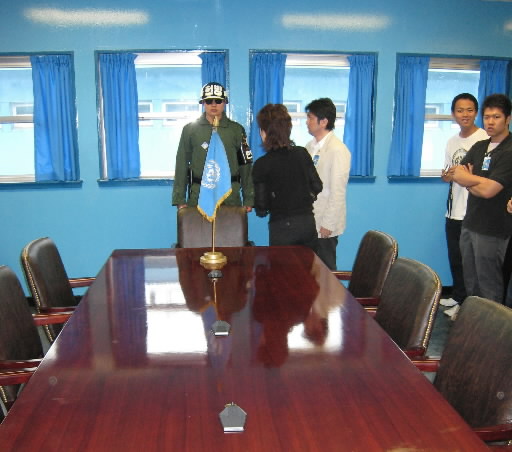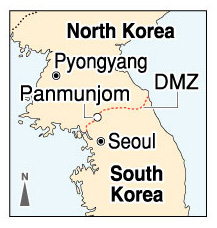Nuclear weapons can be eliminated: Chapter 6, Part 7
Jul. 31, 2009
Chapter 6: Instability in Northeast Asia
Part 7: The path to peace
by Junichiro Hayashi and Yumi Kanazaki, Staff Writers
U.S. holds key to dialogue with North Korea
The military border between South Korea and North Korea runs down the center of a table in a meeting room at Panmunjom on which is displayed the blue flag of the United Nations. Since the negotiation of a cease-fire agreement in the Korean War in 1953, the two countries have sat across this table from each other to discuss military affairs. Tourists are allowed to visit the room, but speaking to the guards is forbidden.
This state of tension between the two countries has continued for more than 50 years, and North Korea’s development of nuclear weapons has prevented the two sides from proceeding from the cease-fire to a peace agreement. Is there no key that will open the heavy door along the 38th Parallel?
Journalist Kang Tae-ho, 51, has reported on diplomatic issues between North and South Korea for The Hankyoreh, a South Korean newspaper, for more than 15 years. “These problems can’t be resolved solely with sanctions and other tough measures,” he said. He proposes creating a “road map to denuclearization” with the aim of getting North Korea to abandon its nuclear weapons by resolving economic and human rights issues that face both countries. Maintaining the current regime is believed to be a major goal of North Korea’s nuclear development program. Mr. Kang believes a security environment that does not include nuclear weapons must be created.
Yun Dukmin, 49, a professor at the Institute of Foreign Affairs and National Security in Seoul, shares a similar view. “Dialogue is the only process that will lead to peace,” he said. “It is worth noting that North Korea has consistently directed its message not at South Korea or China but at the U.S.”
The basis for the belief that the abandonment of nuclear weapons is possible can be found in a January 13 comment by North Korea’s Foreign Ministry in which it said, “When the U.S. nuclear threat is eliminated and there is no longer a nuclear umbrella over South Korea, our nuclear weapons will no longer be necessary.” This statement was made one week before the inauguration of U.S. President Barack Obama.
A joint statement issued after the six-party talks in September 2005 may also provide a basis for this belief. The six nations agreed to observe a “‘words for words,’ ‘actions for actions’ principle stressing ‘mutually coordinated measures.’” According to this, if the U.S. moves to drop its hostile policy toward North Korea, North Korea must move to abandon its nuclear weapons.
But in April North Korea said that it “will never again take part in such [six party] talks and will not be bound by any agreement reached at the talks.” When he visited the U.S. in June, South Korean President Lee Myung-bak advocated continued talks by the remaining five nations, but as yet no mechanism has been created for new talks.
At present it is difficult to predict what North Korea will do next. But for Japan, resuming a dialogue with North Korea is also key to resolving the issue of the abduction of Japanese citizens by North Korea.
Ukeru Magosaki, 65, former director-general of the International Intelligence Bureau of Japan’s Ministry of Foreign Affairs and a professor of defense, said U.S. assurance that North Korea can maintain its regime is a key point. “It depends on whether or not the U.S. can create a diplomatic mechanism by which it indicates that is not seeking the collapse of the North Korean regime,” he said.
Mr. Yun made a similar point. “North Korea won’t change unless the U.S. works toward real change with the cooperation of China, Japan, South Korea, and the other countries concerned,” he said. The diplomatic skills of President Obama, who has stated his desire for a world without nuclear weapons, and the support of the other nations involved will be tested.
(Originally published on July 17, 2009)
To comment on this article, please click the link below. Comments will be moderated and posted in a timely fashion. Comments may also appear in the Chugoku Shimbun newspaper.









